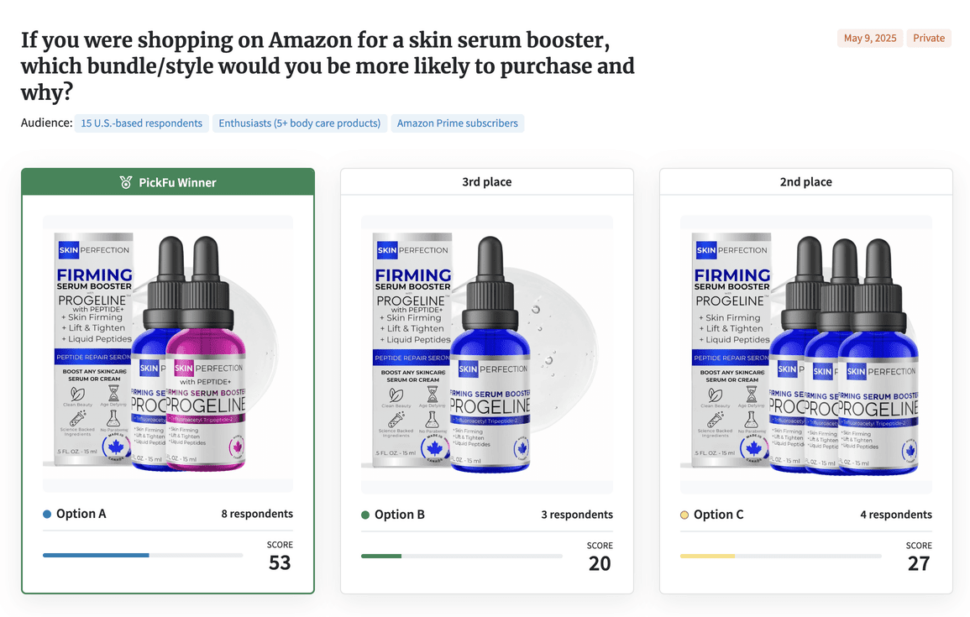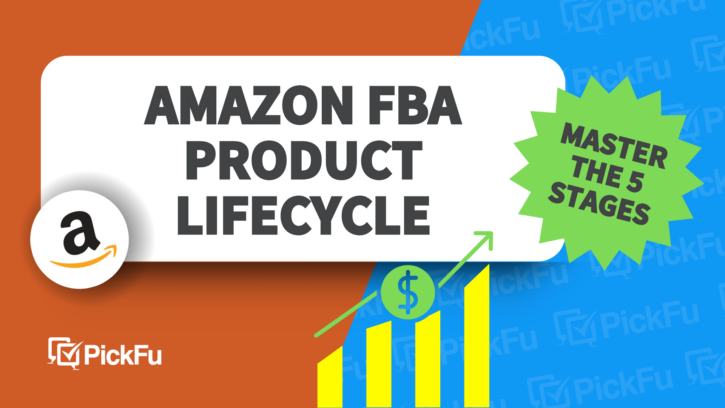If you’ve ever launched or managed a product on Amazon FBA, you know success isn’t a one-and-done deal. From initial concept to final sunset, your product evolves – and your strategy needs to evolve with it.
That’s where the Amazon product lifecycle comes in.
What Is the Amazon Product Lifecycle?
The Amazon product lifecycle refers to the five key stages a product typically moves through from launch to retirement:
- Product Creation & Production – validating product ideas and developing the right version to launch
- Click-Through Rate (CTR) Optimization – optimizing your main image to drive traffic
- Conversion Rate (CVR) Optimization – improving your listing to turn traffic into buyers
- Expansion – introducing new variations, bundles, or related products
- Sunset or Upgrade – determining when to retire or refresh a product
Understanding where your product is in this cycle – and how to test and iterate at each phase – can help you make smarter decisions, avoid costly mistakes, and scale faster.
In this guide, PickFu Brand Evangelist John Aspinall shares real-world strategies for navigating each stage using a skincare serum booster product as an example. Whether you’re just starting out or managing a mature catalog, here’s how to approach the lifecycle like a pro.
Stage 1: Product Creation and Production
Ask: Is this product even worth selling on Amazon?
This is the earliest and most critical phase. It’s when you’re brainstorming ideas, evaluating competitors, and figuring out if the market wants what you plan to sell.
What it means:
The product creation and production stage is all about validating your product concept before you invest in inventory. It includes identifying customer needs, selecting features, pricing competitively, and refining your idea.
How to test it:
With PickFu, you can run open-ended polls to get instant feedback from real Amazon Prime shoppers. John’s example question:
“If you were shopping on Amazon for a skin serum booster with ProGulene peptide, what would you be looking for in terms of ingredients, price, and other features?”
The responses helped identify must-have ingredients (like hyaluronic acid), ideal price points (under $30), and brand perceptions – all before a single unit was manufactured.
💡 Pro tip: Don’t wait until after production to learn what customers want. Use early-stage polling to build a product that’s already in demand. Try this easy product research poll template to get started.
Stage 2: Click-Through Rate (CTR) Optimization
Ask: Will shoppers click on my listing?
Once your product is live (or almost live), your next job is to make sure people are clicking. That starts with your hero image.
What it means:
Amazon CTR, or click-through rate, measures how often people click on your product listing after seeing it in Amazon search results. A low CTR means your listing isn’t standing out.
How to test it:
Use PickFu to A/B test your main image options. John ran a poll comparing blue, green, and pink versions of his skincare product. Same formula, different packaging.
The winner? Blue – associated with cleanliness, trust, and skincare.
Demographic filters revealed extra insight: men overwhelmingly chose blue, while women were split between blue and green. Higher-income shoppers also leaned toward blue.
💡 Pro tip: Don’t assume your favorite image is the winner. Test color schemes, angles, props, and packaging variations with your actual target audience. Try our Amazon main image optimization test for fast results.
Stage 3: Conversion Rate (CVR) Optimization
Ask: Will shoppers buy once they click?
You’ve nailed the click, but clicks alone don’t pay the bills. Now it’s time to optimize your product detail page to convert visitors into customers.
What it means:
CVR, or conversion rate, measures the percentage of people who buy your product after viewing your listing. High traffic + low conversions = missed opportunity.
How to test it:
With PickFu, you can share your actual Amazon listing URL in a poll and ask:
“If you were shopping for a skin serum booster, would you purchase this listing? If not, why?”
Because PickFu displays your full product detail page (title, images, bullet points, A+ content), you get meaningful, qualitative feedback:
- “Too expensive for a brand I don’t know.”
- “Looks professional but needs stronger value messaging.”
- “Would buy if it were closer to $30.”
You can even run head-to-head tests with your competitors’ listings to see what’s working for them – and what’s not.
💡 Pro tip: Price objections, brand trust, and weak differentiation are common CVR killers. Identify them fast and fix what’s holding your listing back.
(And you already know we have a poll template for this to help you get started!)
Stage 4: Expansion
Ask: What should I launch next?
Once your flagship product is gaining traction, the next step is expansion. That could mean launching new variations, bundling related products, or creating a version 2.0.
What it means:
The expansion stage is about scaling your catalog, either horizontally (new SKUs) or vertically (upsells, bundles). It’s how you grow revenue without starting from scratch.
How to test it:
Use PickFu’s ranked polls to compare potential expansions. John ran this test to compare:
- A single bottle of “Peptide Plus” serum
- A two-pack bundle with Peptide Plus and the original
- A three-pack of the original formula

The two-pack bundle with contrasting pink and blue bottles won. Shoppers loved the visual contrast and “two-step” feel. Higher-income shoppers especially favored this version.
💡 Pro tip: Don’t guess which bundle or variation to create. Test the options first to find the most compelling and profitable path forward.
Expansion could also mean selling into new countries or markets – check out this guide to your Amazon global expansion strategy.
Stage 5: Sunset (or Upgrade)
Ask: Is it time to retire or reinvent this product?
Eventually, even your best-sellers will slow down. Maybe competitors are beating you, or market preferences have shifted. This is where you decide to either phase out the product or give it new life.
What it means:
The sunset stage is where you evaluate whether to discontinue a product or invest in a refresh. This could mean new packaging, pricing, or a complete version 2.0.
How to test it:
John tested his aging serum booster against two top-selling competitors using PickFu:
“Which of these product listings would you buy and why?”
His listing came in second – respected, but losing out to a Korean skincare brand that was better known, lower-priced, and had stronger perceived quality.
- Strengths: Familiar branding, masculine packaging, detailed content
- Weaknesses: Price, lack of name recognition, fewer ingredient callouts
💡 Pro tip: When your product stalls, test it head-to-head with competitors. If you’re consistently losing, it’s time to innovate… or move on.
Wrapping Up: Make Smarter Moves at Every Stage
The Amazon product lifecycle isn’t just a concept – it’s a strategic roadmap. By understanding which stage your product is in and using real customer feedback to guide your decisions, you’ll save money, reduce risk, and boost your odds of success.
To recap, here are the five stages again:
- Creation – Validate your idea before you build it
- CTR Optimization – Win the click with a standout main image
- CVR Optimization – Improve your listing to drive conversions
- Expansion – Launch new SKUs based on what customers want
- Sunset – Know when to retire, refresh, or pivot
Use PickFu to Test at Every Stage
With instant feedback from real Amazon shoppers, PickFu helps you eliminate guesswork at every step of the product lifecycle. It’s fast, affordable, and addictively insightful.
🧠 Learn more about the top PickFu tests Amazon sellers run to boost their clicks and sales.
🚀 Or just go ahead and try your first poll for free – just create your account to get started.
No more gut decisions. Just clear data, smarter strategies, and better outcomes on Amazon.



